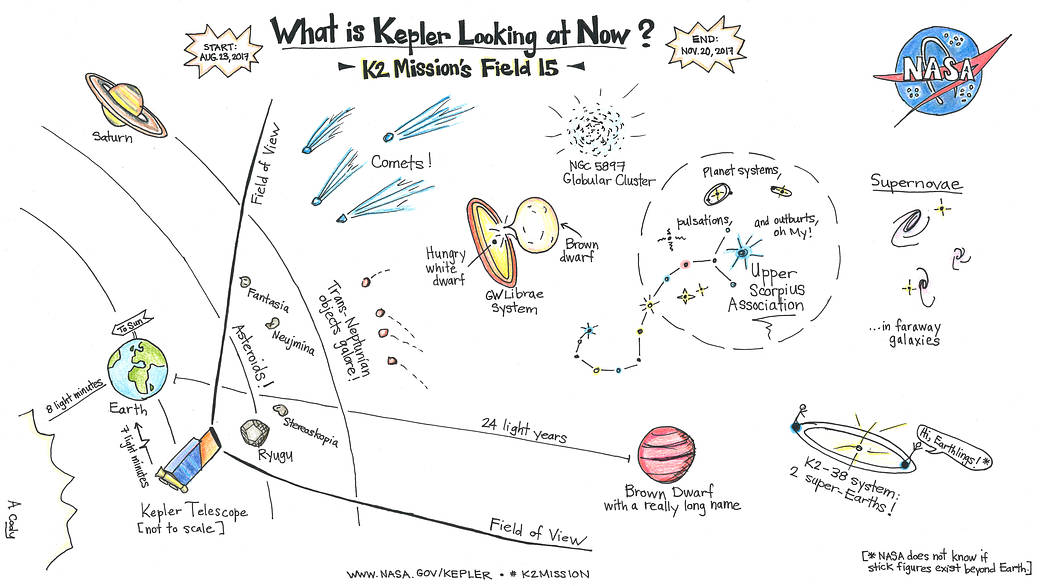
Now in the fifteenth observing campaign of its K2 extended mission, the Kepler Space Telescope is studying more than 23,000 objects located in the direction of the constellation Scorpius. The cartoon illustrates some of the objects of interest that Kepler is observing from Aug. 23 to Nov. 20.
In this swath of sky, called Field 15, Kepler will monitor a variety of astronomical sources of light, including faraway galaxies, star clusters, planetary systems and brown dwarfs. Closer to home, comets traveling from the outer reaches of our solar system on their orbital dance with the sun, and occupants of the main asteroid belt between Mars and Jupiter, will captivate the gaze of the multipurpose planet-hunter.
One particularly interesting object is called GW Librae, a binary star system composed of a pulsating white dwarf and a brown dwarf. In this system, the strong gravity of the white dwarf distorts the brown dwarf and strips away gases from its outer layers. The build up of those gases on the white dwarf causes irregular and significant increases in brightness, and may eventually trigger a supernova explosion that will destroy the system. Scientists will study the brightness changes caused by the duo’s tumultuous tango to better understand the mechanisms that ignite these titanic explosions.
Another system of interest previously discovered by the K2 mission is K2-38. In this planetary system, two super-Earth-size planets orbit a bright sun-like star approximately 600 light-years from Earth. Both planets orbit very close to their star, making them inhospitable for life–stick figure or otherwise–as we know it. The additional observations of the K2 Mission Field 15 will help scientists learn more about the characteristics of the star and enable a search for additional planets in the system.
In addition, Kepler will observe three dozen solar system objects, and will also monitor more than three thousand faraway galaxies for signs of exploding stars or supernovae.
Since May 2014, the Kepler spacecraft has been operating in its second mission called K2. Continuing the search for planets beyond the solar system or exoplanets, the K2 mission expands the scope of study to include notable star clusters, such as the Pleiades and Hyades; young and old stars, such as Aldebaran; distant active galaxies and supernovae.
Unlike its predecessor, the K2 mission studies a different region of the sky known as the ecliptic plane. This is the plane in which Earth and the other planets and moons of our solar system travel on their annual trek around the sun. Along the ecliptic, 19 different fields of view have been identified for scientific investigation.
NASA’s Ames Research Center manages the Kepler and K2 missions for NASA’s Science Mission Directorate. NASA’s Jet Propulsion Laboratory in Pasadena, California, managed Kepler mission development. Ball Aerospace & Technologies Corporation operates the flight system with support from the Laboratory for Atmospheric and Space Physics at the University of Colorado in Boulder.
























